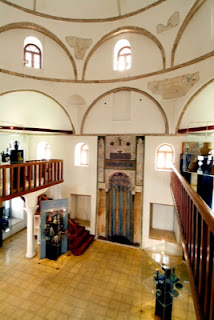 |
| http://media.ems.gr/ekdoseis/makedonika/makedonika_27/ekd_pemk_27_Hatzitrifonos.pdf |
The Ottoman Monuments of Greece
An attempt to record, reveal and protect the Ottoman cultural heritage of Greece
Sunday, June 21, 2015
Yehudi Hamami | Thessaloniki
Tuesday, February 10, 2015
The mosque in Parthenon | Nöel-Marie Lerebours
 |
| Nöel-Marie-Paymal Lerebours, 1842, Αθήνα, το τέμενος στον Παρθενώνα [λεπτομέρεια], (η μοναδική Δαγεροτυπία του τεμένους) |
Thursday, November 24, 2011
Tzisdarakis mosque | Τζαμί Τζισδαράκη (2)
Το Τζαμί της Πλατείας Μοναστηρακίου χτίστηκε το 1759 από τον τότε Βοεβόδα των Αθηνών Τζισδαράκη. Παλιότερα ονομαζόταν Τζαμί του "Κάτω Σιντριβανιού", από το σιντριβάνι που βρισκόταν εκεί κοντά, ενώ ολόκληρη η περιοχή ήταν γνωστή ως "Κάτω Παζάρι".
Μετά την ίδρυση του Ελληνικού Κράτους, το Τζαμί χρησιμοποιήθηκε για ποικίλους σκοπούς (στρατώνας της στρατιωτικής μουσικής, φυλακή, αποθήκη). Το 1915 αναστηλώθηκε από τον Αναστάσιο Ορλάνδο και το 1918 στέγασε το "Μουσείον Ελληνικών Χειροτεχνημάτων" που ιδρύθηκε τότε.
Στο Τζαμί στεγάζεται από το 1975 η πλούσια Συλλογή Κεραμεικής, δωρεά του Καθηγητή Β. Κυριαζόπουλου. Από το 1991, η Συλλογή προβάλλεται με ανανεωμένη εκθεσιακή παρουσίαση.
Βρίσκεται στην οδό Άρεως 1, στην Πλατεία Μοναστηρακίου. Τηλέφωνο επικοινωνίας : 210 32 42 066
Sunday, October 30, 2011
Κουρσούμ τζαμί | Τρίκαλα
Το Κουρσούμ τζαμί στα Τρίκαλα σε καρτ ποστάλ των αρχών του περασμένου αιώνα.
Το μοναδικό έργο του μεγάλου Oθωμανού αρχιτέκτονα Σινάν που διασώζεται σήμερα στον ελλαδικό χώρο είναι το λεγόμενο Κουρσούμ Τζαμί στο Τρίκαλα.
Η ονομασία Κουρσούμ, οφείλεται στην μολυβοσκέπαστη οροφή του. Κουρσούμ στα τουρκικά ονομάζεται το μολύβι, με το οποίο στέγαζαν τζαμιά και παλιότερα οι Βυζαντινοί τρούλους εκκλησιών.
Ο θόλος στο Κουρσούμ Τζαμιού είναι ημισφαιρικός και έχει πολλές και σημαντικές κατασκευαστικές ομοιότητες με το τζαμί Νουρί Οσμανιέ της Κωνσταντινούπολης. Η κορυφή του τρούλου έχει ύψος 22,5 μ. και η διάμετρός του είναι 18 μ.
“Koursoum Mosque”, located on the city of Trikala.
The unique building of the great Ottoman architect Sinan, which can still be found in Greece, is the Osman Shah Mosque, also known as “Koursoum Mosque”, located on the city of Trikala.
It was named after the Turkish word “koursoum”, due to its dome which is covered with lead. The word “koursoum” means “lead”. During the past, the architects would use lead to build the domes of the mosques, as well as the domes of the Byzantine churches.
The dome of the Koursoum Mosque is hemispherical and it bears many significant architectural similarities with the Nuruosmaniye Mosque, which is located in Constantinople. The dome has a diameter of 18 meters and a height of 22.5 meters.
WebRep
currentVote
noRating
noWeight
Monday, October 24, 2011
Castle Teke (or Griva)
Type: Fortification
Date: 1807
Location: Between Vonitsa and Lefkada
Historical Facts: The small fortress was constructed where there had been an Ottoman monastery (teke), already known from the 17th century. It is one of the fortifications which were built by the pasha of Ioannina to control the coasts of Akarnania, mainly during the Russian -Turkish war after 1806. An inscription on the wall states that it was completed in 1807. According to written sources, the plan of the fortress was drawn up by French engineers, and it was used for systematic attacks against the garrison of Lefkada. Today it is in private ownership.
Brief Description: The small fortress follows the standard quadrilateral layout with corner ramparts. The perimeter wall reaches a height of 10 metres and surrounds a small inner yard where the gunpowder store for the complex was situated. An ascending path leads to the en- trance to the castle on the eastern side. Inside the perimeter walls there were a great number of covered areas which met the needs of the garrison.
Bibliography:
G. Remerant, Ali de Tepelen, Pasha de Jiannina 1744-1822, Paris 1828, 115-117. K.H. Maxairas, Lefkas (1700-1864), Athens 1956, 49. K.H. Maxairas, The Lefkada garrison of St. Marina, Athens 1956, 49.
G. Smyris, The network of fortifications of the pasaliki of Ioannina (1788-1822), Ioannina 2004, 175-177.
Sunday, October 23, 2011
The Ottoman monuments of Serres (2)
Coins in the Greek territory under the Ottoman rule (15th - 18th century)
Ασημένια ζολότα Μουσταφά Γ' (1757-1774)
Οθωμανικά νομίσματα της περιόδου Μουσταφά Γ' (1757-1774):
Χρυσό altum (αριστερά κάθετα),
ασημένιο γρόσι (επάνω οριζόντια),
ασημένιος παράς (κάτω οριζόντια).
* Από την εργασία της διευθύντριας ερευνών στο Ινστιτούτο Νεοελληνικών Ερευνών/ΕΙΕ κας Ευτυχίας Λιάτα, με τίτλο: Τα νομίσματα του Βενετοκρατούμενου και Τουρκοκρατούμενου Ελληνικού Χώρου (15ος-18ος αιώνας).
* Από την εργασία της διευθύντριας ερευνών στο Ινστιτούτο Νεοελληνικών Ερευνών/ΕΙΕ κας Ευτυχίας Λιάτα, με τίτλο: Τα νομίσματα του Βενετοκρατούμενου και Τουρκοκρατούμενου Ελληνικού Χώρου (15ος-18ος αιώνας).
Κοπή του παρά με τη μέθοδο του σφυριού σε οθωμανικό νομισματοκοπείο (από μινιατούρα του 15ου αιώνα).
Subscribe to:
Posts (Atom)














